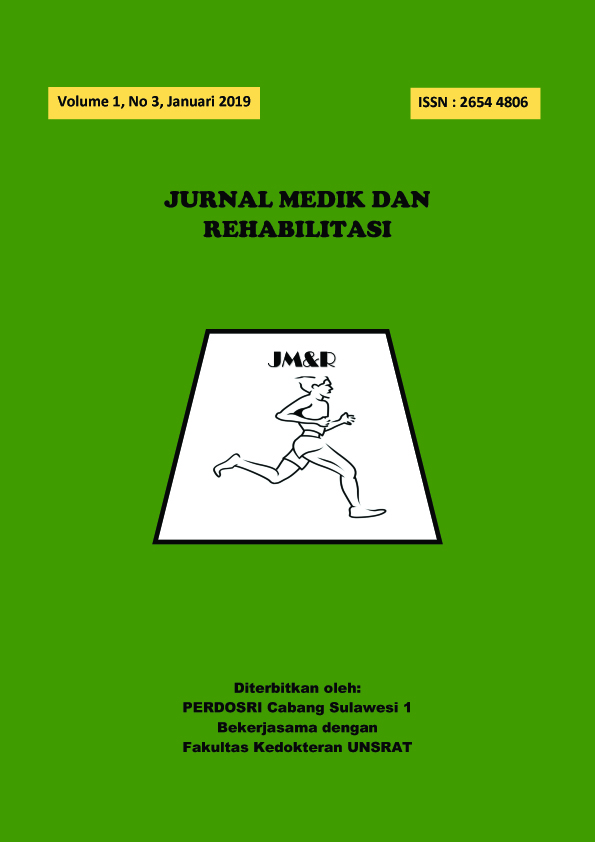HUBUNGAN KADAR HEMOGLOBIN DAN TERCAPAINYA REMISI PADA ANAK PENDERITA LEUKEMIA AKUT
Abstract
Abstract: Leukemia is a blood cell malignancy originating from the bone marrow, which is characterized by the proliferation of white blood cells with the manifestation of abnormal cells in the peripheral blood. Management of acute leukemia until now still relies on chemotherapy as the main therapy. Acute leukemia patients are stated complete remission if there is no sign of leukemia after treatment which means that the bone marrow contains <5% blast cells, the number of blood cells is within normal limits, and there are no signs and symptoms of the disease. This research aims to examine the correlation between hemoglobin levels and the achievement of remission in children with acute leukemia. This research used a retrospective analytical method with a cohort approach. The research sample used secondary data from the medical records of patients with acute pediatric leukemia who had been given induction phase chemotherapy at Estella Foundation of RSUP Prof. Dr. R. D. Kandou Manado the period 2015 to 2018 with a sample of 26 patiens. The data was evaluated and analyzed to see the correlation between hemoglobin levels and the achievement of remission in children with acute leukemia. The result of this data is analyzed using Fisher exact test showed a significant value p=0.641 (p>0.05). Conclusion: There is no significant relationship between the level of hemoglobin and the achievement of remission in children with acute leukemia.
Key words: Hemoglobin levels, remission, acute leukemia.
Â
Abstrak: Leukemia adalah keganasan sel darah yang berasal dari sumsum tulang, yang ditandai oleh proliferasi sel-sel darah putih dengan manifestasi sel-sel abnormal dalam darah tepi. Penatalaksanaan leukemia akut hingga saat ini masih mengandalkan kemoterapi sebagai terapi utama. Pasien leukemia akut dinyatakan remisi lengkap jika tidak ada tanda leukemia setelah pengobatan yang berarti bahwa sumsum tulang mengandung <5% sel blast, jumlah sel darah dalam batas normal, dan tidak ada tanda dan gejala dari penyakit. Tujuan dari penelitian ini adalah untuk mengetahui hubungan antara kadar hemoglobin dan pencapaian remisi pada anak dengan leukemia akut. Penelitian ini bertujuan untuk mengetahui hubungan antara kadar hemoglobin dan tercapainya remisi pada anak-anak dengan leukemia akut. Penelitian ini menggunakan metode analitik retrospektif dengan pendekatan kohort. Sampel penelitian menggunakan data sekunder dari rekam medis pasien anak dengan leukemia akut yang telah diberikan kemoterapi fase induksi di Yayasan Estella RSUP Prof Dr R. D. Kandou Manado periode tahun 2015 hingga 2018 dengan sampel 26 pasien. Data dievaluasi dan dianalisis untuk melihat hubungan antara kadar hemoglobin dan tercapainya remisi pada anak-anak dengan leukemia akut. Hasil dari data ini dianalisis menggunakan Fisher exact test menunjukkan nilai signifikan p = 0,641 (p> 0,05). Kesimpulan: Tidak ada hubungan yang signifikan antara kadar hemoglobin dan tercapainya remisi pada anak-anak dengan leukemia akut.
Kata kunci: Kadar hemoglobin, remisi, leukemia akut.
References
Bambang H.P, Sutaryo, Ugrasena IDG, Endang W, Maria A. Buku Ajar Hematologi-Onkologi Anak. 3rd rev.ed. Jakartta. Ikatan Dokter Anak Indonesia. 2010.h.236-47.
Cancer Stat Fact: Childhood Leukemia. 2015.Availablefrom: https://seer.cancer.gov/statfacts/html/childleuk.html
Lanzkowsky P, Lipton J.M, Jonathan D.F. Lanzkowsky’s Manual of Pediatric Hematology and Oncology. 6th ed. London. Academic Press is an imprint of Elsevier. 2016.h.367-405
Porth C.M. Patophysiology Concepts of Altered Health States 7th ed. Philadelphia. Lippincott William and Wilkins. 2005
Nafrialdi, Sulistia G. Farmakologi dan Terapi 4th ed. Jakarta. Gaya Baru. 2003
Fianza P.I. Buku Ajar Ilmu Penyakit Dalam Jilid II 5th ed. Jakarta. InternaPublishing. 2009
Astriningrum M. Hubungan Tahap Kemoterapi pada Penderita Leukemia Limfoblastik Akut Dengan Status Gizi di Bangsal Ilmu Kesehatan Anak RSUD Dr. Moewardi.Surakarta.Perpustakaan.uns.ac.id. 2011.h.1-49.
Tewuh S. Hubungan Kadar Hemoglobin dengan Peluang Remisi pada Anak Penderita Leukemia Limfoblastik Akut Periode 2010-2014 di RSUP Prof. Dr. R. D. Kandou Manado. Manado. Jurnal e-clinic, Volume 4 Nomor 2, Juli-Desember 2016.h.1-21.
Hoffbrand A.V, Moss P.A.H. Kapita Selekta Hematologi. 6th rev. ed. Brahm U, Setiawan L, Iriani A, transl: Jakarta. ECG. 2014.h.13-219.
Hoffman R, et al. Hematology Basic Principles and Practice. Philadelphia. Churchill Livingstone Elsevier. 2009.
Price S.A, Wilson L.M. Patofisiologi. Jakarta. EGC. 2006.
Maria L, Penarosas P.J, Cusick S, Lynch S. Haemoglobin Concentration for the Diagnosis of Anemia and Assassment of Severity. Vitamin and Mineral Nutrition Information System. Geneva. World Health Organization. 2011.
Mwirigi A, Dillon R, Raj K. Acute leukaemia, Medicine. London. Elsevier. 2017.h.1-6.
Kar A, Hijiya N. Diagnosis and Initial Management of Pediatric Acute Leukemia in the Emergency Department Setting. Chicago. Elsevier. 2018.
Eric D.H. Hematopathology. 3rd ed. London. Academic Press is an imprint of Elsevier. 2018.
Tarlock K, Meshinchi S. Pediatric Acute Myeloid Leukemia: Biology and Therapeutic Implication of Genomic Variants. Seattle. Academic Press is an imprint of Elsevier. 2015.
Rouli, Nababan & Amalia, Pustika. (2016). Anemia pada Penyakit Keganasan Anak. Sari Pediatri. 6. 176. 10.14238/sp6.4.2005.176-81.
Brown JM. The hypoxic cell: a target for selective cancer therapy-eighteenth Bruce F. Cain memorial award lecture. Cancer res 1999; 59:5863-70.
Vaupel P, Kelleher DK, Hockel M. Oxygenation status of malignant tumors: phatogenesis of hypoxia and significance for tumor therapy. Semin oncol 2001; 28(suppl 8):29-35.

